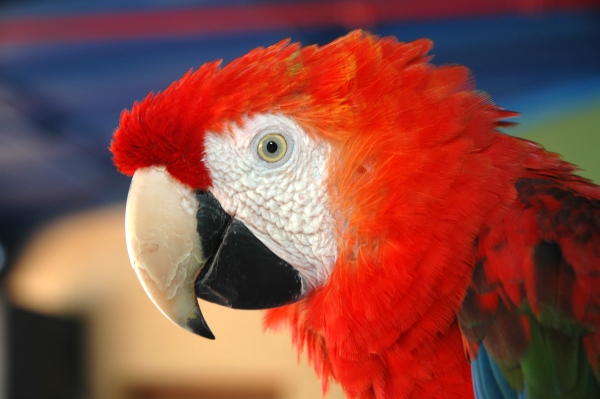
5 February 2014
Last fall Parrot Confidential introduced us to the ARA scarlet macaw recovery project in Costa Rica and a bird named Geoffrey who was abandoned by his mother. I assumed at the time that Geoffrey was rescued because his mother was new to motherhood and unskilled in raising her first brood.
But no. Scarlet macaws have a very unusual parenting strategy. The female lays up to four eggs but when the eggs hatch the parents choose just one of the nestlings — usually the first — and shower it with attention. The rest are ignored, unfed, not brooded. They die within three weeks. The parents purposely raise an only child.
I learned about this very unusual behavior in an article in wired.com about the Tambopata Macaw Project in southeastern Peru. Since 1989 the project has collected a wealth of information on scarlet macaw biology and behavior including the birds’ habit of raising only one chick each year. From Nadia Drake’s article:
Observations suggest that this outcome is one of choice, rather than resource limitation. So far, the reasons why are still a mystery. This parenting strategy seems to be unusual even among birds, which often lay extra eggs and then distribute limited resources among chicks with brutal efficiency.
…
The truth is that macaw chick mortality does not appear to be the accidental or inevitable result of scarce resources.“This is death by neglect,” said ornithologist Donald Brightsmith of Texas A&M University. “Complete and utter neglect.”
— Wired Magazine: Tambopata Macaw Project
Raising only one chick per brood is an unfortunate trait for a bird with a declining population but it explains why the ARA Project has a natural supply of baby scarlet macaws — every nest has an abandoned nestling. By raising the “extra” birds the project boosts the local population.
Scarlet macaws have a reason for choosing to raise an only child. We just don’t know what it is yet.
Read more here at wired.com.
(photo from Wikimedia Commons. Click on the caption to see the original)
I met some of the hand-reared macaws when I was at the Tambopata Research Center last September. The ones who mated with wild macaws did better (in terms of rearing their own offspring) than did the ones who mated with other hand-reared chicks. Also enjoyed a great presentation by research project staff and visited the clay lick nearby that was visted by hundreds of macaws, parrots, parakeets, and many other species (roadside hawk, vermillion flycatcher, band-tailed seedeater, blue-throated piping guan, et al.) – amazing!!!